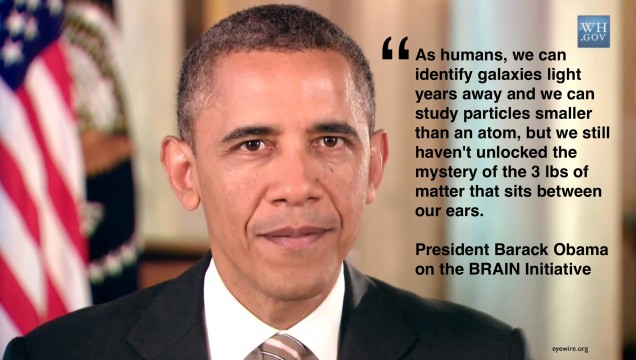Obama’s BAM Project Becomes BRAIN Initiative
 At his State of the Union address nearly two months ago, President Obama announced plans for the Brain Activity Map (BAM) project (see The Nerve blog Part 1 and Part 2), a billion-dollar ten-year research initiative to gain a better understanding of the brain and to provide deeper insights into diseases like Alzheimer Disease, Parkinson Disease, and Autism Spectrum Disorder.
At his State of the Union address nearly two months ago, President Obama announced plans for the Brain Activity Map (BAM) project (see The Nerve blog Part 1 and Part 2), a billion-dollar ten-year research initiative to gain a better understanding of the brain and to provide deeper insights into diseases like Alzheimer Disease, Parkinson Disease, and Autism Spectrum Disorder.
On Tuesday, April 2nd, the President announced that he plans to include the BAM project – now termed the BRAIN (Brain Research through Advancing Innovative Neurotechnologies) Initiative – in his 2014 budget proposal. The director of the NIH, Dr. Francis Collins, notes that one of the major goals of the project is to simultaneously sample from many neurons in real-time. Although existing technology can measure the activities of single neurons and of brain regions, it cannot measure those of circuits. Because existing technology has not yet advanced to a level that allows such complex analysis, the BRAIN initiative will be initially funded $100 million for the year of 2014 to develop and advance neuroscience technologies. Yearly negotiations will take place to determine future funding.
Don’t Panic! – Mice Aren’t Actually the Smartest
 "Man had always assumed that he was more intelligent than dolphins because he had achieved so much — the wheel, New York, wars and so on — whilst all the dolphins had ever done was muck about in the water having a good time. But conversely, the dolphins had always believed that they were far more intelligent than man — for precisely the same reasons....In fact there was only one species on the planet more intelligent than dolphins, and they spent a lot of their time in behavioural research laboratories running round inside wheels and conducting frighteningly elegant and subtle experiments on man. The fact that once again man completely misinterpreted this relationship was entirely according to these creatures' plans." - Douglas Adams, The Hitchhiker's Guide to the Galaxy
"Man had always assumed that he was more intelligent than dolphins because he had achieved so much — the wheel, New York, wars and so on — whilst all the dolphins had ever done was muck about in the water having a good time. But conversely, the dolphins had always believed that they were far more intelligent than man — for precisely the same reasons....In fact there was only one species on the planet more intelligent than dolphins, and they spent a lot of their time in behavioural research laboratories running round inside wheels and conducting frighteningly elegant and subtle experiments on man. The fact that once again man completely misinterpreted this relationship was entirely according to these creatures' plans." - Douglas Adams, The Hitchhiker's Guide to the Galaxy
As tempting as it may be to believe the science fiction version of the intelligence rankings, real-life science has spoken and suggests (much to my displeasure) that humans may actually be the highest on the intelligence scale.
Ketamine: Kan it Kure Depression?
Affective disorders are those disorders of the brain that are characterized by severe and inappropriate shifts in mood or emotion. These shifts are often to extreme ends of the emotional spectrum where an affected individual is constantly full of energy and confidence (mania) or withdrawn, fatigued, and excessively sad with little interest in usually enjoyable activities (depression). Both of these conditions have been observed and recorded in human history for thousands of years but only recently have they been recognized as brain disorders, given names like major depression and bipolar disorder, and treated as medical conditions.
In the past 150 years it has been noted that the onset of depression is occurring at higher rates and at younger ages that ever before. This data could be the result of factors including an increase in patients coming forward to be diagnosed, improved diagnoses, or simply better record keeping. Whatever the reason, it is estimated that 15 to 20% of the population is experiencing symptoms of major depression at any given time, with a greater occurrence in women than in men. Many are affected by this disorder and a cure has yet to be found. But before we continue, a distinction must be made between major depression and “reactive depression” in which a person may feel depressive symptoms because of a single event like the loss of a loved one or a failure of some kind. Major depression is a prolonged state in which an individual may display a number of symptoms including depressed mood, loss of interest in most activity, change in body weight or appetite, changes in sleep patterns, psychomotor agitation or retardation, fatigue, difficulty concentrating, feelings of worthlessness or guilt, and suicidal thoughts. Depending on the severity of the depression a patient may display many, or only a few of these possible symptoms.
More
The Birds
In my vision modeling class this week, we were learning about the structure of the (primate) visual cortex and one of my classmates posed an interesting question: how is it that birds sustain such amazing visual acuity when they don't seem to have the cortical volume to process that detailed information? In other words, how does a bird brain deal witha bird's eye view? I'm curious - and I still am, because so far I have not found a lot of research on the topic. Indeed, I imagine it's difficult to come up with a definitive way to determine what a bird is experiencing for the sake of a laboratory experiment. Although, if I had to hazard a guess, perhaps much of a bird's reaction to what it sees relies on more primitive structures - maybe birds rely more on instinct than interpretation? While this seems to remain mysterious, scientists do know some neat stuff about how birds' eyes function in ways that allow them to see what we can't. Check it out!
More
Telepathic rats communicate via brain-to-brain connections

Scientists from Duke University and Brazil claim wires connecting one rodent to another can allow communication spanning continents via the internet. Professor Miguel Nicolelis of Duke University in Durham, North Carolina, led a team of researchers who demonstrated that it is possible to transmit instructions from one animal to another by brain-to-brain communication, a process akin to telepathy.
Brain-to-brain communication could be the start of organic-based computing based on networks of interconnected brains. Pairs of laboratory rats were able to communicate with each other using microscopic electrodes implanted into their brains. This occurred as part of an experiment where the two rats had to work together in order to receive a reward (see video at source).
Are you flushing away brain cells? How urine cells can give rise to neurons
Uh-oh, urine trouble! Well, now that that’s out of my system (ahem), how would you feel if you learned that you’ve been flushing away potential brain cells? I’m not talking about the copious amount of hours you’ve logged online or kicked back in front of the television just this past month. On a daily basis, you’re expelling 1-2 liters of a possible source of neurons in a way you’ve never expected – through urinating.

Back in 2009, stem-cell biologist Duanqing Pei demonstrated that kidney epithelial cells, a common component of urine, could be converted into induced pluripotent stem (iPS) cells, which have the ability to differentiate into any cell type found in the body. Recently, Pei and his colleagues at China’s Guangzhou Institutes of Biomedicine and Health took this technique a step further by converting iPS cells into functioning neurons. More
A Blacked Out Memory
"White Mike and his father moved after his mother died of breast cancer. It ate her up and most of their money. They can't control the old radiators and its very hot in the spring time. In White Mike's room, old unpacked boxes stick out of the closet so he can see them. Maybe you know how it is, maybe you don't? But sometimes if you can't see what you're finished with its better. White Mike stripped to his shorts and laid down on the floor so he felt a little cooler. That's how it was the first night in his new room and that's how it still is. White Mike is thin and pale like smoke. White Mike has never smoked a cigarette in his life, never had a drink, never sucked down a doobie. He once went three days without sleep as a kind of experiment. That's as close as he's ever gotten to fucked up. White Mike has become a very good drug dealer.
More
Connectionism
In light of the Obama Administration's decision to commit $3 billion over 10 years to NIH's Brain Activity Map project, we thought it may be important to go back to our roots.
Who are we? This is the ultimate question posed by all of Western thinking and perhaps NIH's Brain Activity Map is the culmination of our efforts. The goal of the project, in a nutshell, is "mapping the activity of every neuron in the human brain in 10 years." Absurd, outrageous, momentous, profound! Okay, so when did we decide that this was possible, or even that we should try? In their modern form, these beliefs spring from a movement in cognitive science called Connectionism.
Thank you, President O-BAM-A! Yours truly, the Neuroscience Community
Whether you’ve read an article, listened to the radio, watched the news, or heard from a friend, I'm sure you already know that President Obama and his administration have been planning to enrich our future as mind and brain enthusiasts. However, if you have been under a rock, studying for midterms, or working (way too much), you may be asking – how? Well, do you know the whole Human Genome Project thing? How it revolutionized genetics? Just like geneticists who were able to map the complete human genome by 2003, neuroscientists will be given the goal of more fully understanding the human brain by building a map of its activity.
America's Stutter-free Idol
On January 17th, the talented Lazaro Arbos, a 21-year-old from Florida, went viral on Youtube for his amazing performance during his American Idol audition. The most impressive part of his beautiful voice? The fact that it was stutter-free.
During normal speech, Arbos involuntarily makes long pauses and extended vowels, using his hands to trace the words he is trying to convey. However, as soon as he starts to sing, the difficulty disappears. His new Twitter fans are calling it a divine miracle, but the phenomenon is well-known to many stutter sufferers - industry legend has it that B.B.King and Carly Simon were among them!
What's going on here? The disorder is highly varied in its presentation and severity, so science is far from a consensus about the etiology, though there have been some compelling findings. One 2003 study by Van Borsel et al. at the Ghent University Hospital in Belgium showed a marked increase in activation of the right hemisphere during speech in fMRI studies of patients with the speech disorder; more so than in normal speakers, leading to the idea that perhaps this over-activation is interfering with the fluent production of speech on the left. Specifically, a study of stutterers in Frankfurt, Germany found that activity in the right frontal operculum was negatively correlated with the severity of stuttering symptoms in patients, suggesting a compensational role. This area has been associated with timing tasks in speech in healthy controls, adding further possible significance to the specific dysfunction in verbal timing seen in stutterers.
More

